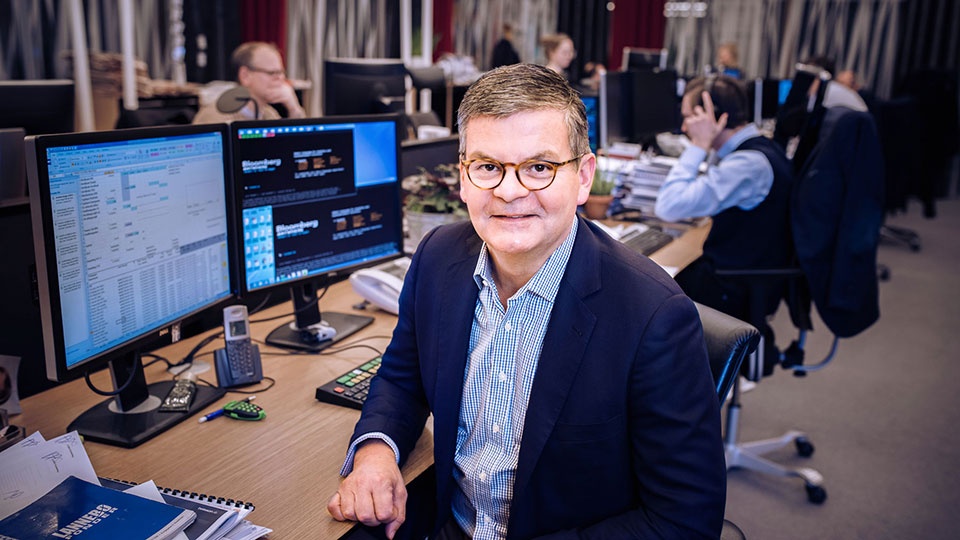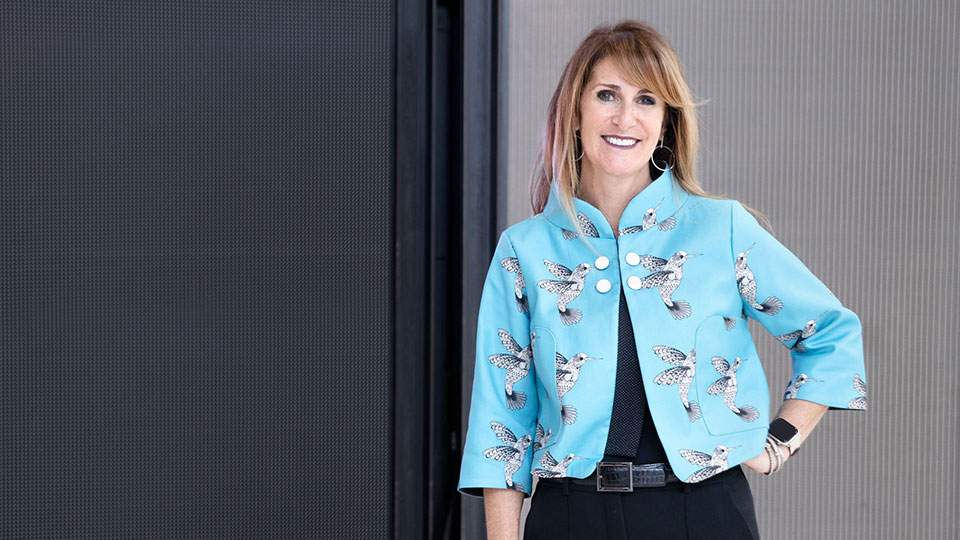
Across the globe, climate change is changing the way we live, what we eat and what we buy. Companies in every industry are transforming how they do business and figuring out how to protect against climate risk. Or at least they should be, say experts, because climate change isn’t a distant future threat. It’s happening now.
“There are two big reasons why companies should care about climate change,” says Rachelle Sampson, an associate professor of logistics, business and public policy who teaches sustainability courses in Smith’s MBA program. “There’s the existential risk that climate change poses for society as a whole, which tells us that doing something about it is just fundamentally the right thing to do. And then, of course, there’s the bottom line.”
For businesses, the changing climate poses risks that could dramatically impact operations, revenues and markets.
Some of the risks are physical. Weather events like hurricanes, floods and fires can cause damage to manufacturing plants, disrupt supply chains or impact employees’ ability to work.
Other risks are regulatory. Governments could impose—and in some places already have imposed—limits on carbon emissions and other restrictions. They could also require companies to disclose what they and their suppliers are doing.
On March 21, 2022, the U.S. Securities and Exchange Commission introduced a sweeping new climate disclosure rule that says public companies must reveal their impact on the Earth’s climate to shareholders and the federal government.
The proposed rule is currently in a 60-day public comment period, but when enacted, failure to comply could mean big fines for businesses or big changes to business practices.
Mitigating Risks
The pandemic revealed how quickly risks can become reality. Companies in every industry need to take action now, say experts, including Sandor Boyson, a professor emeritus of supply chain. As it stands, most aren’t prepared.
Boyson recently led a research project with supply chain mapping company Resilinc and UMD’s Earth System Science Interdisciplinary Center (ESSIC). The study of 12,000 U.S., Chinese and Taiwanese production sites in the high tech, auto and consumer goods industries examined temperature and precipitation data spanning two decades, connecting the data to business impacts (such as revenue at risk) and disruptions during extreme climate-related events.
The results were alarming. Of the sites analyzed, only 12% were ready for climate-related disruptions, with backup manufacturing and distribution plans in place, as well as formal business continuity and incident response plans.
Boyson outlines a playbook for manufacturers to mitigate climate-related risks, including measures to assess their supply chains, as well as the key risk factors for each site and supplier. Preparing for unknown future disruptions means making improvements now, he says.
Taking this kind of proactive long-term view is exactly what companies should be doing, says Sampson.
In research she conducted with FCLTGlobal and the Wharton School’s ESG Analytics Lab, where she’s a visiting scholar, she finds the companies whose strategies take various stakeholders into account do better in the long run than those that are solely focused on shareholder returns. It’s not enough for companies to say they care about the environment and people—they have to do the work.
The Dean’s Professor of Accounting Rebecca Hann’s latest research studies whether talking the climate talk matters for investors. Hann and her co-authors look at whether companies’ discussion of their climate risks during earnings conference calls helps investors assess the impact of the international Paris Climate Agreement on firm value. They find that when companies reveal their vulnerabilities, they actually help clear up investor uncertainty associated with future policy changes and regulatory costs—and see an improvement in their valuations, especially for the most carbon-intensive firms like oil and gas companies.
“When firms have reliable information and good policies in place, it can be beneficial to reveal more, rather than revealing less, even when they come with risks and uncertainties” says Hann. “Capital markets play an important role in our fight against global warming. Institutional investors definitely pay attention to climate risk exposure and use that information to choose their portfolios. If companies care about firm value and want to raise capital, they need to care not just about their climate risk exposure, but also how to reveal that information to investors.”

Appealing to Investors
Göran Espelund, MBA ’87, has been choosing portfolios based on climate risks for nearly a decade. In 2000, he co-founded Lannebo Fonder, an investment fund company based in Stockholm.
In 2013, at the urging of clients, the firm signed onto the United Nations-supported Principles for Responsible Investments, a network of investors that focuses on making sustainable investment decisions along environmental, social and governance (ESG) factors.
Companies that fall into the ESG category are generally intent on reducing their environmental impact and improving the way they do business to be more sustainable. These companies are doing things like actively working to reduce their carbon footprint, or creating or harnessing alter-natives to fossil fuels.
And these companies are growing in number. Investors are increasingly interested in putting their money into ESG companies. For Lannebo, it quickly became clear that focusing on good sustainability is good business.
“For a company today going forward, if you don’t incorporate these issues, we don’t think you’re going to be long-term successful. That’s really what we invest in, and what we invest our clients’ money in—companies that will be successful over the long term.”
ESG investing has become a big focus in Europe. Espelund points to global fund flows just in the fourth quarter of 2021: “About 25%—$147 billion—went into funds with clear sustainability angles. But 80% of that was in Europe—the U.S. was only 10%.”
Bloomberg forecasts that globally, ESG assets will exceed $54 trillion by 2025, making up more than a third of the $140.5 trillion projected total assets under management.
ESG investing is gaining traction in the United States. In his annual letter to CEOs in January, Larry Fink, CEO of BlackRock, the world’s largest asset manager with $10 trillion under management, called on companies to practice stakeholder capitalism and to disclose more information about their targets for reducing greenhouse gas emissions.
But it’s going to take more than pleas from investors.
“As much as BlackRock is trying, they aren’t going to be able to change the world by themselves,” says Russ Wermers, the Paul J. Cinquegrana ’63 Endowed Chair in Finance and director of the Center for Financial Policy. “Regulators are going to have to set standards so this can be done.”
The Coming Regulations
The SEC’s climate risk disclosure rule lays out a framework for companies to report information about their climate-related risks in their annual reports and stock registration statements.
Wermers isn’t surprised to see the SEC’s climate disclosure plan from Chair Gary Gensler, who has made climate risk a top priority. The question now is whether it can withstand opposition and potential challenges in court from critics who say emissions-related data falls outside the financial regulator’s jurisdiction.
In Europe, the European Union’s Taxonomy Regulation, adopted in April 2021, established a framework for businesses and investors on environmental sustainability disclosures. And in February, the European Union proposed further regulations on sustainability due diligence and value chains that would include U.S. firms over a certain size operating in Europe.
“Regulators are really going to go for it, because of the political climate and the increasing evidence that global warming is getting away from us,” says Wermers. “Investors obviously care about this, but they need accurate information to measure ‘greenness’ and carbon emissions. There are a lot of investment funds that are saying they are green, but there is no real standard for sizing up companies.”
And therein lies a problem: An incentive for companies to “greenwash”—to say they are doing environmentally sustainable things when they actually aren’t.
“There are a lot of ways to be green,” he says. “Any clarification of the playing field—what qualifies as ‘green’ and how do you measure ‘greenness’ at the corporate level, how do you disclose it—will benefit all corporations so they can make efficient capital investment decisions.”
Right now, companies might be wasting time and money on the wrong things—making large investments in so-called green technologies that do too little, says Wermers. “New regulations will be good for companies that actually are making the move to carbon reduction,” he says. “They will be incentivized and will receive fair valuations for conducting such efforts.”
The SEC’s rule will require companies to disclose their greenhouse gas emissions and environmental impacts, along with analyses of how various climate scenarios could impact their business.
They would be projecting risks to their physical assets—plants, factories, pipelines, shipping modes—as well as human capital assets, quantifying how those risks would impact their balance sheets.
But actually figuring out all of those numbers isn’t easy.
Calculating Risks
Clifford Rossi is an expert in risk, having spent 25 years in risk management at banks and government agencies before joining the finance faculty at Smith. He recalls how talk of financial risks from natural disasters intensified with Hurricane Katrina in 2005.
“We weren’t saying the words ‘climate risk’ back then, but we were certainly saying there were external events that can come along and create lots of losses for us if we’re not careful,” says Rossi.
Now he spends a lot of his time working to figure out how to best assess climate risk. He has testified before congressional committees and he’s working with Wermers and University of Maryland atmospheric and oceanic science associate professor Timothy Canty to launch an interdisciplinary Climate Finance and Risk Management Certificate Program to help professionals across industries figure out how best to assess risk.
Rossi says the current models for figuring out the risk just aren’t good enough.
Today, big banks like Citigroup, where Rossi was chief risk officer for the $300-billion Consumer Lending Division during the 2008 financial crisis, have to conduct annual stress tests to determine whether they have sufficient capital to withstand a severely adverse event. Rossi says adding a climate change scenario stress test to look decades in the future—part of the SEC’s rule and which has already been imposed on banks in Europe—would be futile.
“It’s just a feel-good exercise,” he says. “Banks’ strategic planning horizon certainly might be within three to five years, but a 10-year horizon is a stretch, and anything beyond that is a guess.”
Rossi said banks are in the process of adding experts to their staff to figure out how best to assess this risk that is so different from other risks—where they are highly dependent on scientists, an unusual place to be for the banking sector. He says banks and other companies should start with understanding their physical risks and the risks to the assets they hold in their portfolios, based on climatological changes—flood risk, for example—because climate risk is so complicated.
“This is truly global in scope and it is affecting not just the physical aspects of the globe, but also the financial, the socioeconomic, the political,” Rossi says. “That leaves an enormous amount of unknowns for anybody that’s used to trying to manage risk. Managing uncertainty is a much harder game, because if it’s defined as uncertain that means you may not even be aware of it, but if you are, you don’t have good data to model it.”
Rossi and Canty are trying to solve that problem, too.
They recently launched Deucalion Climate Risk Solutions, a startup in the UMD Ventures tech transfer program. They used UMD research and technology to create a better way for financial services companies and government agencies to model flood risk, and eventually other climate risks.
With looming regulations, it’s an area where banks and companies are going to have to invest.
“Every company, whether a financial services company or not, has to pay close attention to what’s coming, because it’s going to impact everybody.”
Reasons for Optimism
Sampson is skeptical that effective regulations will be enacted soon.
“I’ve doubled-down on firms as actors,” she says. “They have to be part of the solution, and they can be much more nimble and quick, in terms of responding to these problems. Human ingenuity is such that they can come up with these solutions quickly.”
Espelund says he is excited about the role businesses can play. The best companies will figure out how to innovate to turn one of the world’s greatest challenges into their greatest opportunity.
“The corporate sector will be a super important part, because that’s where most of the innovation will happen,” he says.
And when governments and companies work together, big things can happen quickly. The success of the creation of the COVID-19 vaccines, he says, is a standout, recent example.
The many innovations in the works right now—carbon-free steel, carbon-free cement, mini clean nuclear plants—make Espelund particularly hopeful. “I’ve been working in this industry for over 30 years and I’ve never seen so much capital for good ideas,” he says.
“The market is already giving very nice valuations to companies that are seen as being far ahead in the transition. That’s a very, very good driver.”
Tesla is a notable example. With a current market valuation of more than $1 trillion, the all-electric car company tops the combined value of rivals Toyota, Volkswagen, Daimler, Ford and General Motors.
“Now you see everyone running for electric vehicles. That can go for a lot of industries,” he says.
Good Business
Companies that want to make a difference for the environment and their bottom line don’t have to disrupt an entire industry. They can make simple operational changes—switching to sustainable energy sources, reducing waste, and adapting to consumer preferences.
Those moves also deliver another, often overlooked benefit, Sampson says.
“When firms make a commitment to a mission that extends beyond financials to say, reducing carbon emissions and improving sustainable practices, and they get their employees behind it, there is less turnover, employees are more engaged
and they are more productive.”
Those management practices are good for business and workplace morale—and when a few firms adopt them, others tend to follow suit, Sampson says.
“It can amplify very quickly,” she says. “That’s part of the reason why I’m optimistic. The movement is nonlinear—it can start slow then really ramp up fast.”
In 10 years, Espelund thinks sustainability and accounting for climate risk will be standard business practices—just part of what running a company is all about, like good strategy, marketing and HR. Running sustainable businesses isn’t altruism, he says.
“Good sustainability is good business. If you don’t do it, you’re going to be left behind. We will go carbon-free. Those that come up with the new technologies are going to grab a big market. And that’s going to be profitable.”

Here's What You Can Do
Meg Goldthwaite, MBA ’96, says her first personal connection to the environment was through water, chasing tadpoles in creeks as a child. “I pull my energy, my solace, my strength from the water,” she says. “Nature feeds me.”
Joining the team at The Nature Conservancy, the 70-year-old global environmental nonprofit, felt right.
“I wanted to be part of the team that shares breakthrough stories that connect people to the nature that sustains them,” says Goldthwaite, who serves as the chief marketing and communications officer. “And in telling those stories, we can shift minds, protect our planet, and save lives.”
She says everyone can take meaningful action on climate change—not just governments and Fortune 500 companies.
“It can seem daunting to know where to begin when headlines are so grim—it seems insurmount-able,” she says. “But, there are so many things we can do that collectively add up to a lot.” You can:
- Reduce your food waste.
- Reduce your energy consumption.
- Use public transportation. Take the bus a few times a week instead of driving. And if you don’t have good public transportation—advocate for it.
- Diversify your diet. Replace land-based meats with more fish and vegetables.
- Make your next car or truck electric.
“I think the biggest thing you can do is talk about it. Katharine Hayhoe, the Nature Conservancy’s chief scientist, says talking about our goals for a healthier future and planet can inspire others to start making changes, too. The most important thing we have is our voice.”
Media Contact
Greg Muraski
Media Relations Manager
301-405-5283
301-892-0973 Mobile
gmuraski@umd.edu
About the University of Maryland's Robert H. Smith School of Business
The Robert H. Smith School of Business is an internationally recognized leader in management education and research. One of 12 colleges and schools at the University of Maryland, College Park, the Smith School offers undergraduate, full-time and flex MBA, executive MBA, online MBA, business master’s, PhD and executive education programs, as well as outreach services to the corporate community. The school offers its degree, custom and certification programs in learning locations in North America and Asia.